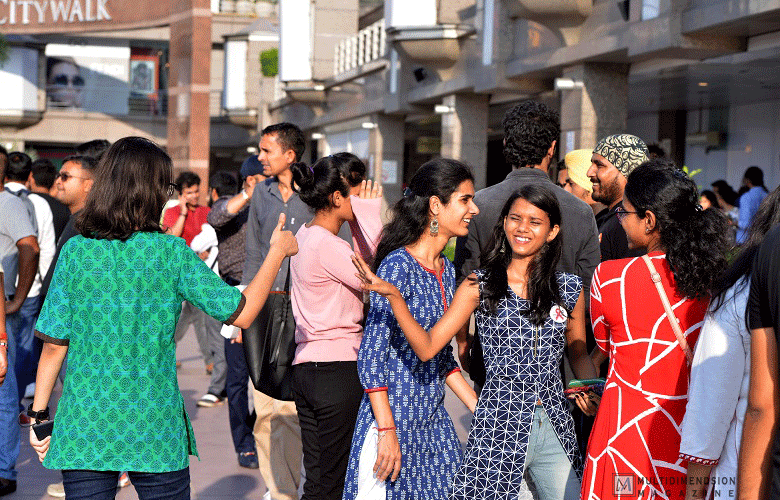Written by: Simran Saini
Delhi, India
Photo Credit: Prem Singh
As the face of a city changes, so does the people residing in it. Or maybe vice-versa. Such is the story of the National capital and its lifestyle which is changing at the speed of one restobar/month. Maybe we don’t notice some things when we’re a part of it, but if you take a step back, a lot seems to have changed. This is exactly what happened when I came back to my hometown Delhi, after spending three years in Paris.
Living in Paris, it was never difficult to find a bar for a glass of wine or beer – every neighborhood had more than one! When people asked me about the drinking culture in India, I always used to say ‘there isn’t even a bar close to my place’! This statement that I made over and over again, back in 2014, was proving to be false each passing day. When I came back in 2017, much had changed. The entire main road of ‘Rajouri Garden’ near my place in West Delhi, which I remembered as a hub of ‘family restaurants’ had turned into a bar hub. Young girls dressed in flashy clothes and high heels, boys in swanky cars looking for parking in the congested service lane – heading over to one of the many over-priced restobars serving ‘desi’ versions of Occidental dishes. Chicken tikka pizza, penne makhani, French fries chat – every Indian dish had been paired with random occidental ones.
It took me a while to realize that this was nothing but the result of the ‘young’ generation taking over. The babies born in the 90s/2000s were now turning legal for driving and alcohol consumption. The town was being painted young, and the results were loudly visible.
Pick up a book about the history of ‘Dilli’, and you’ll learn that when Shahjahan moved his capital to the area around the Red fort that is known as Old Delhi, it was a nurturing ground for poets. Where young blood sung poetry and songs of love, not much has changed at the core of their hearts. Only the face of expression has changed. Today, the generation of young Dilliwalas who are living ‘one weekend at a time’, are found packed in clubs flashing colorful trippy lights and loud music – as the weekend dawns and the young blood is 3 glasses down, the band plays covers of old hindi music about lovers who parted, a broken heart and the good old days. The crowd sings along, smiles and imagines a face close to their hearts. 6 glasses down, and the music changes to Bollywood hip-hop and top numbers from the rest of the world – strangers smile at strangers and dance to another weekend night of drowning their sorrows. At other times, they work hard, and secretly plan to quit their mundane jobs to be a painter, writer, musician, photographer etc. They jam and post their videos to YouTube, they create instagram handles for their poetry and photography, they launch Facebook pages for their make-up business and they all dream to make it big someday, in order to find an escape from their ‘nine to five’ lives.
This generation who is referred to as ‘rebels’ by the previous one, has labeled themselves as what we call ‘young, wild and free’. This is the generation that dares to dream, and turn around the societal norms because they have the courage the say ‘NO’. But in a country which is moving towards a global culture, while trying to preserve its own, the capital might be giving rise to a culture which is not in compliance with the rest of the country as yet. The young Delhiites might feel connected to their counterparts in other metropolitan cities like Mumbai and Bangalore, but what really is alarming is the reason behind a lifestyle change that shocks the previous generation.
A Google search about the youth in Delhi clearly indicates that this generation is battling its own problems. ‘Depressed, alone and ignored’, ‘Youth today battling mood swings, depression’, ‘Awareness of mental disorders among youth in Delhi’ – these are only a few of the headlines that you might come across. Clearly, the reason behind the changing lifestyle of this city is rooted in their changing ‘lives’. Where ‘drinking culture’ is a newly added term to the dictionary of Indian youth, there is bound to be a clash of generations. It might be difficult for the previous generation, their parents, to comprehend the changing demands of their offspring, and a lifestyle they do not approve of.
This change is not just being felt, but is now also a part of the film industry which has started taking up these issues. In a recently released film called ‘Karwaan’, legendary actor Irrfan Khan delivers quite an apt dialogue when he observes a group of young Indians drinking by the pool in broad daylight: ‘Itni si khushi ke liye kitna nasha karna padta hai inn logon ko’/ ‘They need to be so intoxicated in order to be a little happy’.
Could that be the harsh reality then? Is the young generation of a country that boasts of scriptures that teach about contentment and peace, struggling to find happiness and battling depression in this way?




